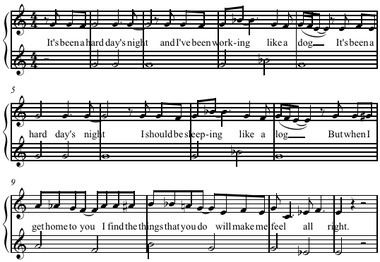 | ||
A modal frame in music is one of "a number of types permeating and unifying African, European, and American song" and melody. It may also be called a melodic mode, "mode" and "frame" being used interchangeably in this context, without reference to scalar or rhythmic modes. Melodic modes define and generate melodies that are not determined by harmony but purely by melody. A note frame is a melodic mode that is atonic (without a tonic) or has an unstable tonic.
Modal frames may be defined by their:
and also define melody types, such as;
Further defined features include;
Example
The modal frame of The Beatles' "A Hard Day's Night" features a ladder of thirds axially centered on G with a ceiling note of B♭ and floor note of E[♭] (the low C being a passing tone):
According to Middleton, the song, "at first glance major-key-with-modal-touches", reveals through its "Line of Latent Mode" "a deep kinship with typical blues melodic structures: it is centred on three of the notes of the minor-pentatonic mode [on C: C, E-flat, F, G, B-flat] (E♭-G-B♭), with the contradictory major seventh (B♮) set against that. Moreover, the shape assumed by these notes - the modal frame - as well as the abstract scale they represent, is revealed, too; and this - an initial, repeated circling round the dominant (G), with an excursion to its minor third (B♭), 'answered' by a fall to the 'symmetrical' minor third of the tonic (E♭) - is a common pattern in blues."
